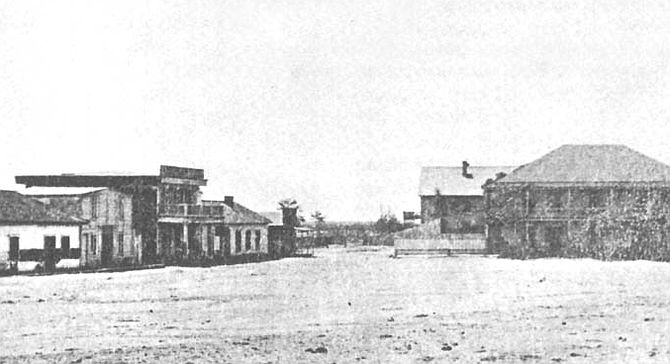 Facebook
Facebook
 X
X
 Instagram
Instagram
 TikTok
TikTok
 Youtube
Youtube

“ROBERT PATTERSON EFF1NGER: LETTERS FROM SAN DIEGO, 1849”
CAROL JUDITH SCHILLE,
MASTER’S THESIS,
SDSU, 1986
The San Diego Historical Society has all 11 of Effinger’s letters. Schille’s thesis is at the SDSU library.
Two events that changed the West happened almost simultaneously. On January 24.1849, gold was discovered at Sutter’s Mill. Nine days later, Mexico signed the Treaty of Guadalupe Hidalgo. This ceded Alta California to the United States. Article V of the treaty stipulated that commissioners from Mexico and the U.S. meet in San Diego and mark the boundary line between the two countries.
In 1849 an estimated 100,000 people, mostly males, came to California in search of gold. They sailed around Cape Horn, or came overland through Mexico and the Southwest, or across the malaria-infested Isthmus of Panama.
Early in 1849, 23-year-old Robert Patterson Effinger left Ohio with several friends. They headed for San Francisco and the gold fields. At a stop in New Orleans, Effinger met Colonel John B. Weller, head of the U.S. Boundary Commission. Even though he “disliked” Weller, Effinger signed on “as part of his retinue —at the expense of Uncle Sam.”
He became officer in charge of stores.
Effinger spent six months — from June 10 to November 28, 1849 — in and around San Diego, marking the U.S.-Mexican border. He wrote 11 letters to his family in Lancaster, Ohio.
Effinger never described his work. He wrote quickly, in “snatches,” and always with a sense that negative comments might come back to haunt him. “People (in San Diegoj live to a remarkable age — I know women here who are great-grandmothers and yet look younger than Mrs. Daugherty — yet by this I would not wish to intimate that Mrs. D. is getting old or that she could become a great-grandmother by emigrating to California.”
Effinger’s letters paint a stark picture of California. He sees a raw country, ravaged by greed and illusion: “No place under God’s heaven has been more misrepresented — the only reason why one half of the emigrants don’t turn back is because they are out of funds & the other half keep moving out of false pride.”
To Effinger, Schille writes, “San Diego resembled 'nothing more or less than an Indian Village’.... There were none of the amenities of the established eastern communities...no hotels, no boarding houses. The once-flourishing Mission of San Diego was now old and deserted.... Other visitors at that time called it 'a miserable seaport town.’"
Effinger considered himself superior to nonwhites. Traveling west was part of his “manifest destiny.” As Schille writes: “Effinger encountered people different from himself, and his comments revealed his racial prejudice, his anti-Catholic sentiment, and his strong ethnocentrism. In this he was not unlike many who came to San Diego at [that] time.”*
MASTER'S THESIS EXCERPTS:


“ROBERT PATTERSON EFF1NGER: LETTERS FROM SAN DIEGO, 1849”
CAROL JUDITH SCHILLE,
MASTER’S THESIS,
SDSU, 1986
The San Diego Historical Society has all 11 of Effinger’s letters. Schille’s thesis is at the SDSU library.
Two events that changed the West happened almost simultaneously. On January 24.1849, gold was discovered at Sutter’s Mill. Nine days later, Mexico signed the Treaty of Guadalupe Hidalgo. This ceded Alta California to the United States. Article V of the treaty stipulated that commissioners from Mexico and the U.S. meet in San Diego and mark the boundary line between the two countries.
In 1849 an estimated 100,000 people, mostly males, came to California in search of gold. They sailed around Cape Horn, or came overland through Mexico and the Southwest, or across the malaria-infested Isthmus of Panama.
Early in 1849, 23-year-old Robert Patterson Effinger left Ohio with several friends. They headed for San Francisco and the gold fields. At a stop in New Orleans, Effinger met Colonel John B. Weller, head of the U.S. Boundary Commission. Even though he “disliked” Weller, Effinger signed on “as part of his retinue —at the expense of Uncle Sam.”
He became officer in charge of stores.
Effinger spent six months — from June 10 to November 28, 1849 — in and around San Diego, marking the U.S.-Mexican border. He wrote 11 letters to his family in Lancaster, Ohio.
Effinger never described his work. He wrote quickly, in “snatches,” and always with a sense that negative comments might come back to haunt him. “People (in San Diegoj live to a remarkable age — I know women here who are great-grandmothers and yet look younger than Mrs. Daugherty — yet by this I would not wish to intimate that Mrs. D. is getting old or that she could become a great-grandmother by emigrating to California.”
Effinger’s letters paint a stark picture of California. He sees a raw country, ravaged by greed and illusion: “No place under God’s heaven has been more misrepresented — the only reason why one half of the emigrants don’t turn back is because they are out of funds & the other half keep moving out of false pride.”
To Effinger, Schille writes, “San Diego resembled 'nothing more or less than an Indian Village’.... There were none of the amenities of the established eastern communities...no hotels, no boarding houses. The once-flourishing Mission of San Diego was now old and deserted.... Other visitors at that time called it 'a miserable seaport town.’"
Effinger considered himself superior to nonwhites. Traveling west was part of his “manifest destiny.” As Schille writes: “Effinger encountered people different from himself, and his comments revealed his racial prejudice, his anti-Catholic sentiment, and his strong ethnocentrism. In this he was not unlike many who came to San Diego at [that] time.”*
MASTER'S THESIS EXCERPTS: